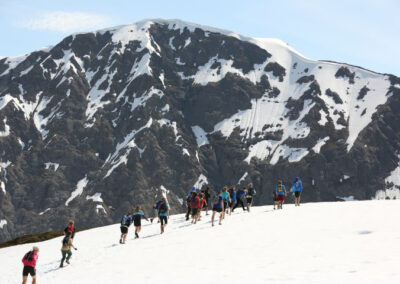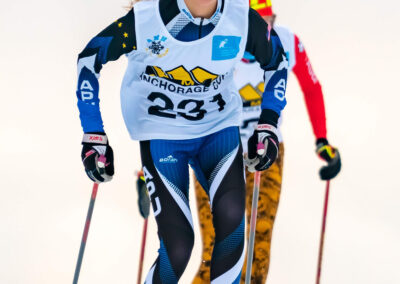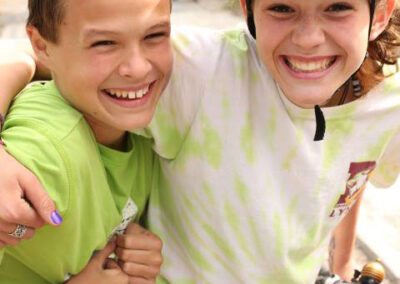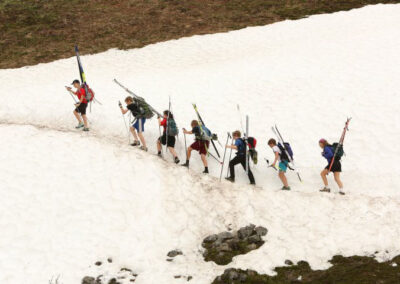Groms Program (4th-6th grade)
The Groms is an APUNSC year-round program built for elementary school age children in 4th through 6th grade. The program is designed to allow motivated kids an opportunity to expand their skiing potential! Groms get to emphasize fun while developing a lifelong love of the outdoors and sliding on snow. By joining Groms, kids will get to interact with other skiers from across the Anchorage bowl in a safe and friendly environment. Children will be coached by our professional staff of experienced coaches.
Grom (short for “Grommet”) originated in the surfing world meaning a young surfer. Skiers and snowboarders also started to utilize the term, and liked it so much that now it is synonymous with any youngling on skis or a board.
During Summer and Fall sessions Groms will be running, hiking, and bounding around the trails. Once the snow flies, we’ll be on skis as much as possible!
Training is typically located at Hillside, APU, and Kincaid. Athletes will also take special training sessions to run in the mountains or ski other trails.
Program Coordinator: Galen Johnston
Coaches: Anna Darnell, Sean Clapp
Summer (April 29, 2024 to August 15, 2024) …….. $850
3 sessions per week, Monday, Wednesday and Thursday. Sessions are 5:00-6:00PM during ASD School Year, and 10:45AM-12:00PM during ASD summer break.
Fall (August 19, 2024 to October 3, 2024) …….. $290
3 sessions per week, Monday, Wednesday and Thursday, 5:00 – 6:00PM
Winter 2 Day (October 7, 2024 to April 3, 2025) …….. $870
Monday and Wednesday, 5:00 – 6:00PM
OR Tuesday and Thursday, 5:00 – 6:00PM
Winter 4 Day (October 7, 2024 to April 3, 2025) ……. $1,340
Monday through Thursday, 5:00 – 6:00PM
Year Round with Winter 2 day option (April 29, 2024 to April 3, 2025) …….. $1,390
All seasonal programs (with Winter 2 day) at reduced rate, bi-annual payment plan available.
Year Round with Winter 4 day option (April 29, 2024 to April 3, 2025) …….. $1,960
All seasonal programs (with Winter 4 day) at reduced rate, bi-annual payment plan available.
- APU (map link) – Meet on the lawn in front of Atwood Center.
- Hilltop Ski Area (map link) – Meet at the far end of the inner parking area at the Nordic Ski Trailhead.
- Kincaid Park (map link) – Meet on the north side of the lower parking lot. (Below Gong Hill)
- Glen Alps (map link) – Meet at the main trailhead.
- Prospect Heights (map link) – Meet at the main trailhead.
- Upper Huffman (map link) – Meet at the main trailhead.
- Rabbit Lake Trailhead (map link) – Meet at the main trailhead.
Dryland (Summer/Fall)
- Classic or “Bounding” poles – For days that we run and bound with poles. Your winter classic poles will work just fine, though if you have something a little shorter (fit in the armpit) that is ideal. Often just with growth this is the perfect use of last winter’s classics…
- Mountain Bike – Good tire tread and mechanically sound. Riders need to be able to shift gears easily, and brakes should be in good working order
- Bike Helmet
- Running shoes – Shoes with good tread are a requirement. Beyond that, find something that is comfortable for running and moving in! Avoid overly heavy, clunky shoes that don’t move well with your feet.
- Drink Belt or Hydration Pack – For Mountain Run days it’s good to have a little water, a snack, and a way to carry a rain/wind jacket
On Snow (Winter)
- Running Shoes – Studded shoes or removable ice cleats recommended
- Ski Boots – Fit is key. Find the boot that is comfortable for your foot in a skiing motion. Most Jr. Boots are a combi style boot meaning they work for skate and classic. This works great for Groms! As skiers grow and develop you may look at technique specific boots instead but likely not until your skier is a Devo age athlete.
- Skate Poles – Length should be between lower lip and nose.
- Classic Poles – Length to top of strap attachment should be 83% of body height standing in classic ski boots, or shorter.
- Rock Skis – A separate pair of skis for both Skate and Classic techniques is ideal though not required. Pick up the cheapest pair(s) you can find at Play it Again Sports or a Swap or Craigslist even. These are skis that serve dual purpose. You don’t have to care about them so much since they were cheap, so we can ski in marginal conditions, get scratches, and not worry about them! This allows us to explore more, and get on snow earlier in the year. If you race, these make great warm up skis to ski on while your coaches are busy waxing your other skis to race on!
- Race Skis (Skate and Classic) A separate pair of skis for both Skate and Classic techniques is encouraged.
- Skate Skis – For fit, look to have the ski length be somewhere between the top of the head and up to 4” taller than head height. If buying used, ideally look for something from someone who was/is a similar weight and height range. Skate ski flex can be as complicated and as technical as you want to make it. It’s not an exact science, and there is a lot of wiggle room! Don’t stress over it too much. If it glides, and is roughly the right size, it’ll be fun!
- Classic Skis – Waxable skis are STRONGLY encouraged. Waxless skis are acceptable for rock skis, but are too slow and do not allow for good technique development. Classic ski fit is very weight dependent for a good fit. The skier needs to be able to close the ski to the snow by standing on one foot and rolling up on the ball of the foot. Without this, they won’t be able to achieve kick and classic will be a less than pleasant experience. If purchasing used equipment it would be worth either consulting a coach, or getting the skis flex tested to determine proper fit. Most ski shops have a glass bench that they can have you stand on, on the skis and slide paper under each ski to determine how it fits and if you can close it. Length can vary between the middle of the forearm (when held straight up above the head) to the crease of the wrist. Longer skis are slightly harder to control, but yield faster glide and in some cases better stability.
- Combi Skis – Combi skis are also an option in lieu of the technique specific skis listed above. This can be a decent option, especially for smaller skiers. However, as we’ll be switching back and forth between skate and classic during the week, there is some work required at home to scrape off old kick wax before skate days.
Wax
- Classic Kick Wax – Lots of companies to choose from. Pick a basic line from one company and get to know it. One of each of the below waxes will cover most conditions.
- Cork – Synthetic Corks work most efficiently
- Binder- optional. Ironed onto bare base to increase kick and durability of kick wax layers.
- Blue – Swix V40, Toko Blue, Start Blue are all good options
- Violet – Swix V45 or V50, Start Purple, Toko Red
- Red – Swix V60, Toko Yellow, Start Red or Yellow
- Klister – Swix KX40S, Swix Silver Universal (can applicator is super easy…)
- Glide Wax – Optional, but advised. Waxing skis regularly allows for skis to be faster and last longer. A good liquid glide wax will help a lot as well, but without the extra paraphernalia. Feel free to ask for guidance.
- Waxing form
- Waxing Iron
- Wax – A “Green”, a “Blue” and a “Red” wax are good places to start
- Scraper
- Groove scraper
- Metal Brush – Copper or Steel
- Nylon/Horsehair Brush
Clothing
- Hat – Something to keep your ears warm and your head covered
- Gloves – Low profile but warm is ideal.
- Mittens – If your hands ever get cold check out Toko, or Swix brand mittens. They are thin, so they fit in ski pole straps, but also very warm!
- Buff – Or other face/neck cover. Just wearing this around your throat warms the air going into your lungs. Optional – Cold air Mask – Airtrim makes a good mask that allows air to be warmed and moisturized as it comes into your lungs. If you have trouble breathing in the cold, or simply want to look out for your lungs, this is a good thing to have in the kit! They’re great for warming up for cold races…
- Jacket – Something that you can move in that isn’t overly bulky, but will keep you warm. Ideally an outer material that snow doesn’t stick to too badly.
- Pants – Not overly bulky, but warm. Ideally an outer material that snow doesn’t stick to too badly.
- Long underwear – Top and Bottom. Something other than cotton!
- Race suit – Optional. Spandex to race in. Wind Briefs – If you’re wearing a spandex suit and you’re a boy you need these. I promise you will regret it if you don’t wear them…
- Drink Belt or water bottle carrier. Optional. If you like a little water on the ski this is a good investment.
- Boot Covers
- Basic Physical Fitness – Groms should be able to run or ski for 10-15 minutes without stopping and be able to move for over an hour with short breaks.
- Health – Participants must be healthy to participate in practice. Stay home and take rest when you’re sick. Communicate with the Coach any existing injuries that may be affected by performing in our practice activities.
- Readiness – Participants are expected to arrive in time to receive important instructions given at the beginning of each practice, and with appropriate gear (see Equipment).
- 2022-23 Besh Cups Races, organized by Cross Country Alaska, sanctioned by US Ski & Snowboard (must be a USSS member).
- Anchorage Cup Races organized by NSAA
- Middle School Racing organized by NSAA
- Registration Payments and Waivers All registration is online and required before attending the first session.
- Besh Cup Race Support is included in the membership fees.
- Family Discount after purchasing two year round memberships, all additional memberships are half price. Please contact coaches to get a registration coupon.
REGISTER ONLINE NOW
One-Week Trial Membership
If you want to check out the program before signing up, we offer a one-week trial membership for new members.
One Week Trial Registration »








